Abstract
OBJECTIVE: The purpose of this study was to evaluate the relation of oxygen delivery (DO2) to the occurrence of multiple organ dysfunction (MOD) in patients with ruptured abdominal aortic aneurysms (AAA). SUMMARY BACKGROUND DATA: Patients with ruptured AAA are at high risk for the development of MOD and death. Previous reports of high-risk general surgical patients have shown improved survival when higher levels of DO2 are achieved. METHODS: Hemodynamic data were collected at 4-hour intervals on 57 consecutive patients (mean age, 70.5 years) who survived 24 hours after repair of infrarenal ruptured AAA. Patients were resuscitated to standard parameters of perfusion (pulse, blood pressure, urine output, normal base deficit). MOD was determined based on six organ systems. Standard parametric (analysis of variance, t tests) and nonparametric (chi square, Wilcoxon) tests were used to compare hemodynamic data, red blood cell requirements, colon ischemia, and organ failure for patients with and without MOD. RESULTS: Patients who developed MOD had a significantly lower cardiac index and DO2 for the first 12 hours; the difference was most significant at 8 hours. Logistic regression analysis demonstrated that the strongest predictors of MOD were DO2, early onset of renal failure, and total number of red blood cells transfused. CONCLUSIONS: DO2 is an earlier and better predictor of MOD after ruptured AAA than previously identified risk factors. Failure to achieve a normal DO2 in the first 8 hours after repair is strongly associated with the development of MOD and a high mortality. Strategies to restore normal DO2 may be useful to improve outcome in these high-risk patients.
Full text
PDF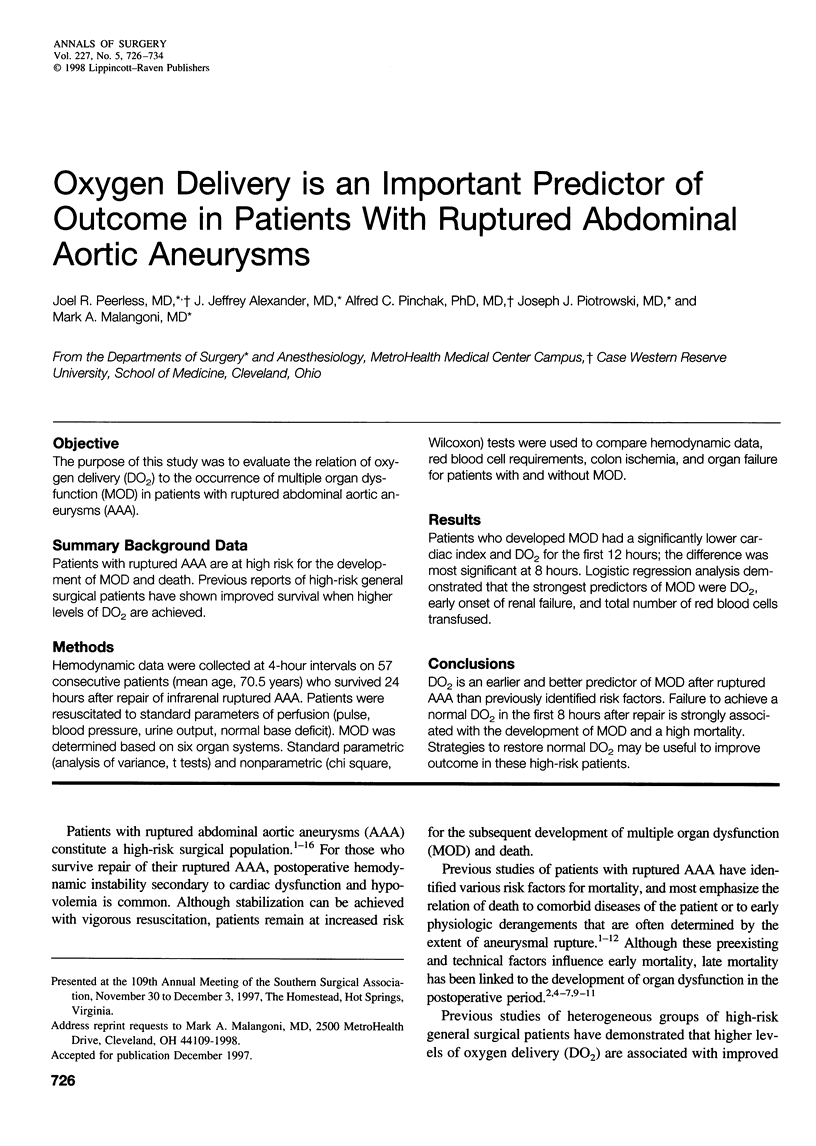
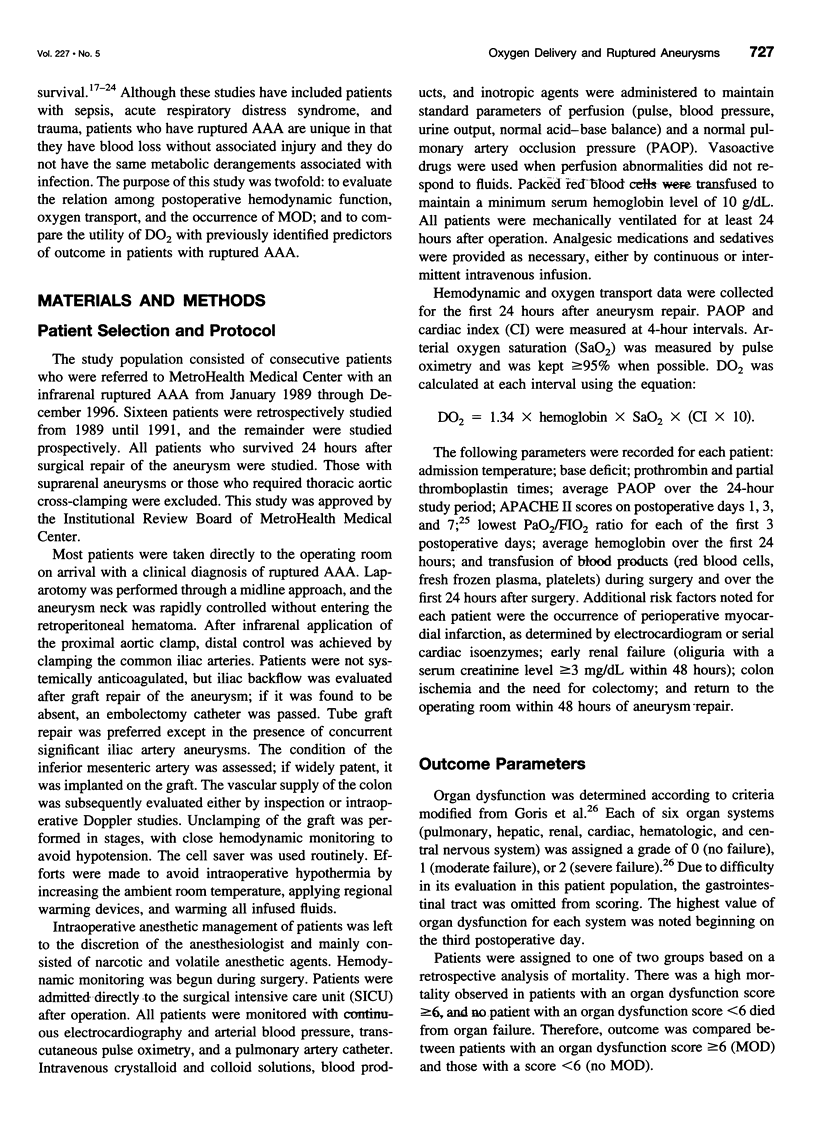
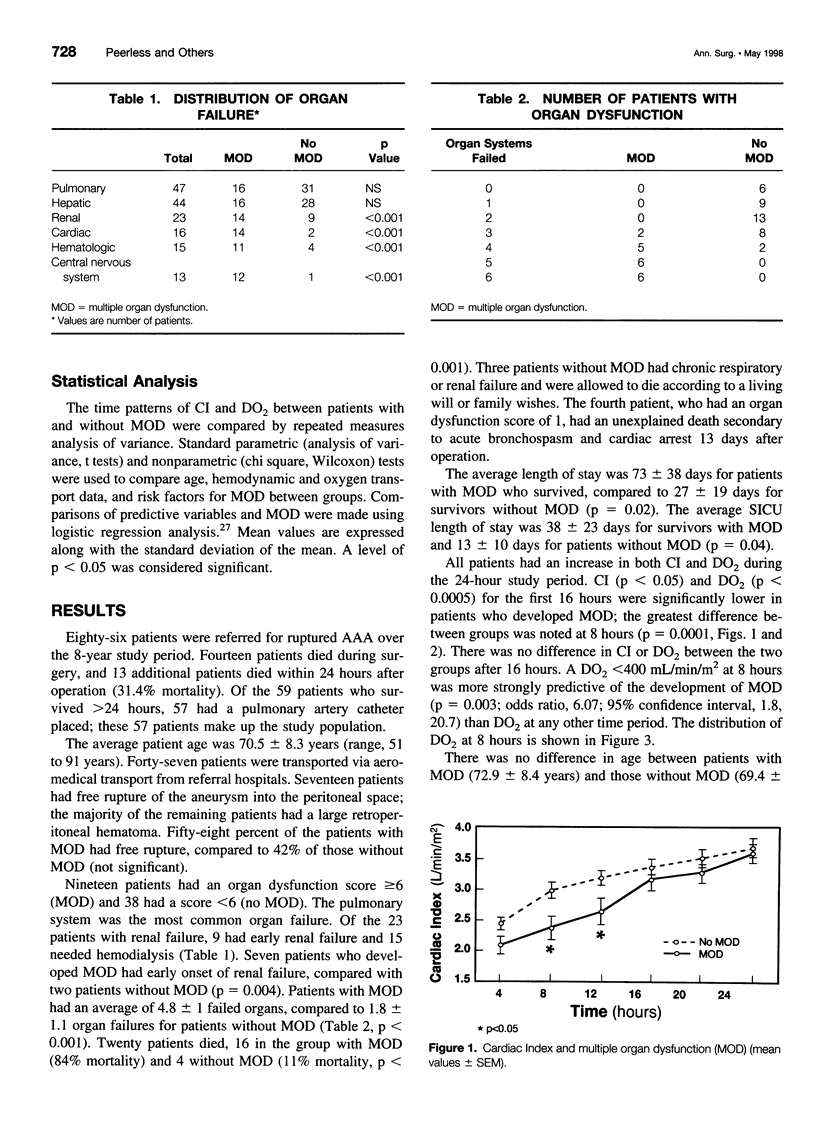
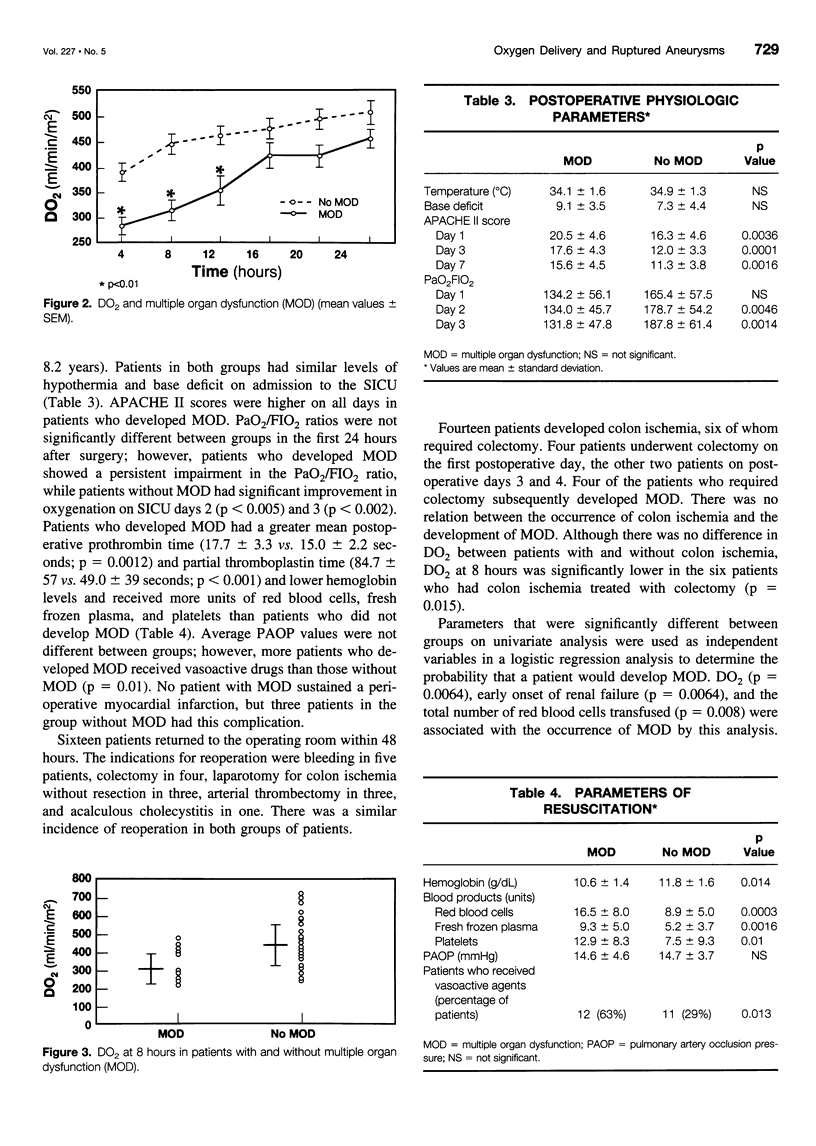
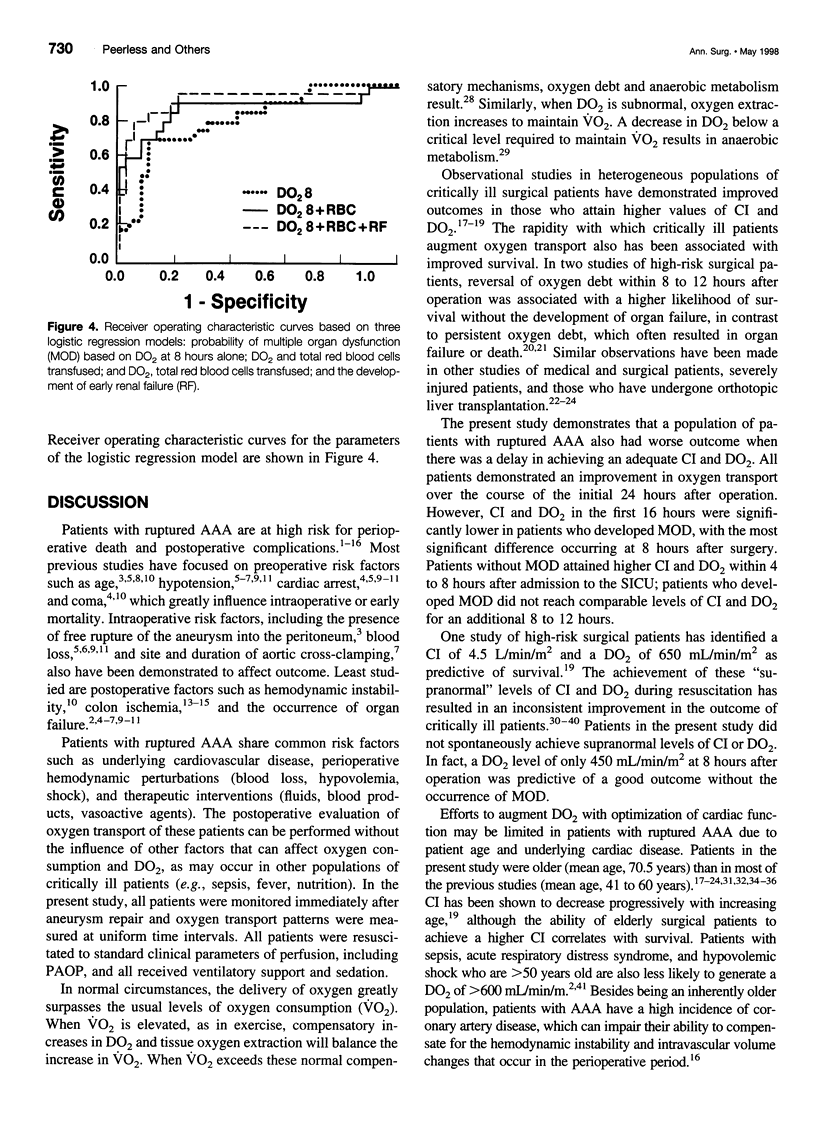
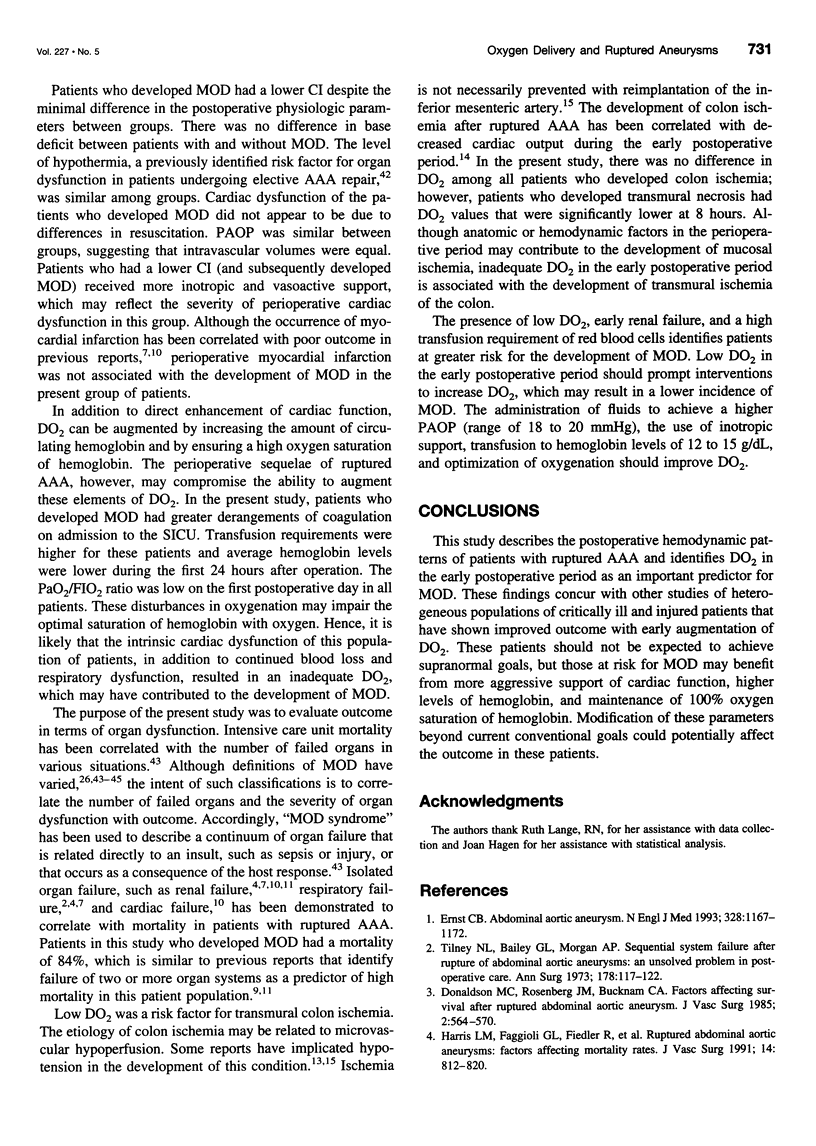
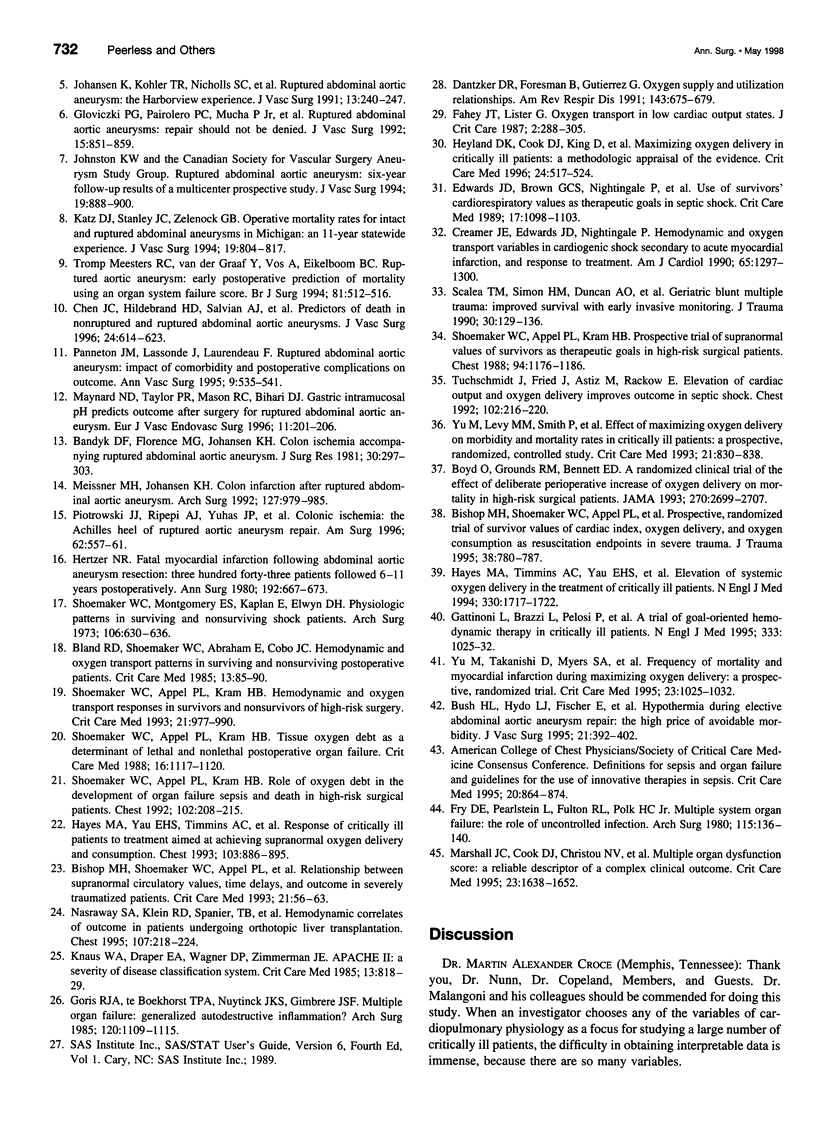
Selected References
These references are in PubMed. This may not be the complete list of references from this article.
- Bandyk D. F., Florence M. G., Johansen K. H. Colon ischemia accompanying ruptured abdominal aortic aneurysm. J Surg Res. 1981 Mar;30(3):297–303. doi: 10.1016/0022-4804(81)90164-5. [DOI] [PubMed] [Google Scholar]
- Bishop M. H., Shoemaker W. C., Appel P. L., Meade P., Ordog G. J., Wasserberger J., Wo C. J., Rimle D. A., Kram H. B., Umali R. Prospective, randomized trial of survivor values of cardiac index, oxygen delivery, and oxygen consumption as resuscitation endpoints in severe trauma. J Trauma. 1995 May;38(5):780–787. doi: 10.1097/00005373-199505000-00018. [DOI] [PubMed] [Google Scholar]
- Bishop M. H., Shoemaker W. C., Appel P. L., Wo C. J., Zwick C., Kram H. B., Meade P., Kennedy F., Fleming A. W. Relationship between supranormal circulatory values, time delays, and outcome in severely traumatized patients. Crit Care Med. 1993 Jan;21(1):56–63. doi: 10.1097/00003246-199301000-00013. [DOI] [PubMed] [Google Scholar]
- Bland R. D., Shoemaker W. C., Abraham E., Cobo J. C. Hemodynamic and oxygen transport patterns in surviving and nonsurviving postoperative patients. Crit Care Med. 1985 Feb;13(2):85–90. doi: 10.1097/00003246-198502000-00006. [DOI] [PubMed] [Google Scholar]
- Boyd O., Grounds R. M., Bennett E. D. A randomized clinical trial of the effect of deliberate perioperative increase of oxygen delivery on mortality in high-risk surgical patients. JAMA. 1993 Dec 8;270(22):2699–2707. [PubMed] [Google Scholar]
- Bush H. L., Jr, Hydo L. J., Fischer E., Fantini G. A., Silane M. F., Barie P. S. Hypothermia during elective abdominal aortic aneurysm repair: the high price of avoidable morbidity. J Vasc Surg. 1995 Mar;21(3):392–402. doi: 10.1016/s0741-5214(95)70281-4. [DOI] [PubMed] [Google Scholar]
- Chen J. C., Hildebrand H. D., Salvian A. J., Taylor D. C., Strandberg S., Myckatyn T. M., Hsiang Y. N. Predictors of death in nonruptured and ruptured abdominal aortic aneurysms. J Vasc Surg. 1996 Oct;24(4):614–623. doi: 10.1016/s0741-5214(96)70077-0. [DOI] [PubMed] [Google Scholar]
- Creamer J. E., Edwards J. D., Nightingale P. Hemodynamic and oxygen transport variables in cardiogenic shock secondary to acute myocardial infarction, and response to treatment. Am J Cardiol. 1990 Jun 1;65(20):1297–1300. doi: 10.1016/0002-9149(90)91316-x. [DOI] [PubMed] [Google Scholar]
- Dantzker D. R., Foresman B., Gutierrez G. Oxygen supply and utilization relationships. A reevaluation. Am Rev Respir Dis. 1991 Mar;143(3):675–679. doi: 10.1164/ajrccm/143.3.675. [DOI] [PubMed] [Google Scholar]
- Donaldson M. C., Rosenberg J. M., Bucknam C. A. Factors affecting survival after ruptured abdominal aortic aneurysm. J Vasc Surg. 1985 Jul;2(4):564–570. [PubMed] [Google Scholar]
- Edwards J. D., Brown G. C., Nightingale P., Slater R. M., Faragher E. B. Use of survivors' cardiorespiratory values as therapeutic goals in septic shock. Crit Care Med. 1989 Nov;17(11):1098–1103. doi: 10.1097/00003246-198911000-00002. [DOI] [PubMed] [Google Scholar]
- Ernst C. B. Abdominal aortic aneurysm. N Engl J Med. 1993 Apr 22;328(16):1167–1172. doi: 10.1056/NEJM199304223281607. [DOI] [PubMed] [Google Scholar]
- Fry D. E., Pearlstein L., Fulton R. L., Polk H. C., Jr Multiple system organ failure. The role of uncontrolled infection. Arch Surg. 1980 Feb;115(2):136–140. doi: 10.1001/archsurg.1980.01380020006003. [DOI] [PubMed] [Google Scholar]
- Gattinoni L., Brazzi L., Pelosi P., Latini R., Tognoni G., Pesenti A., Fumagalli R. A trial of goal-oriented hemodynamic therapy in critically ill patients. SvO2 Collaborative Group. N Engl J Med. 1995 Oct 19;333(16):1025–1032. doi: 10.1056/NEJM199510193331601. [DOI] [PubMed] [Google Scholar]
- Gloviczki P., Pairolero P. C., Mucha P., Jr, Farnell M. B., Hallett J. W., Jr, Ilstrup D. M., Toomey B. J., Weaver A. L., Bower T. C., Bourchier R. G. Ruptured abdominal aortic aneurysms: repair should not be denied. J Vasc Surg. 1992 May;15(5):851–859. [PubMed] [Google Scholar]
- Goris R. J., te Boekhorst T. P., Nuytinck J. K., Gimbrère J. S. Multiple-organ failure. Generalized autodestructive inflammation? Arch Surg. 1985 Oct;120(10):1109–1115. doi: 10.1001/archsurg.1985.01390340007001. [DOI] [PubMed] [Google Scholar]
- Harris L. M., Faggioli G. L., Fiedler R., Curl G. R., Ricotta J. J. Ruptured abdominal aortic aneurysms: factors affecting mortality rates. J Vasc Surg. 1991 Dec;14(6):812–820. doi: 10.1067/mva.1991.33494. [DOI] [PubMed] [Google Scholar]
- Hayes M. A., Timmins A. C., Yau E. H., Palazzo M., Hinds C. J., Watson D. Elevation of systemic oxygen delivery in the treatment of critically ill patients. N Engl J Med. 1994 Jun 16;330(24):1717–1722. doi: 10.1056/NEJM199406163302404. [DOI] [PubMed] [Google Scholar]
- Hayes M. A., Yau E. H., Timmins A. C., Hinds C. J., Watson D. Response of critically ill patients to treatment aimed at achieving supranormal oxygen delivery and consumption. Relationship to outcome. Chest. 1993 Mar;103(3):886–895. doi: 10.1378/chest.103.3.886. [DOI] [PubMed] [Google Scholar]
- Hertzer N. R. Fatal myocardial infarction following abdominal aortic aneurysm resection. Three hundred forty-three patients followed 6--11 years postoperatively. Ann Surg. 1980 Nov;192(5):667–673. doi: 10.1097/00000658-198019250-00013. [DOI] [PMC free article] [PubMed] [Google Scholar]
- Heyland D. K., Cook D. J., King D., Kernerman P., Brun-Buisson C. Maximizing oxygen delivery in critically ill patients: a methodologic appraisal of the evidence. Crit Care Med. 1996 Mar;24(3):517–524. doi: 10.1097/00003246-199603000-00025. [DOI] [PubMed] [Google Scholar]
- Johansen K., Kohler T. R., Nicholls S. C., Zierler R. E., Clowes A. W., Kazmers A. Ruptured abdominal aortic aneurysm: the Harborview experience. J Vasc Surg. 1991 Feb;13(2):240–247. [PubMed] [Google Scholar]
- Johnston K. W. Ruptured abdominal aortic aneurysm: six-year follow-up results of a multicenter prospective study. Canadian Society for Vascular Surgery Aneurysm Study Group. J Vasc Surg. 1994 May;19(5):888–900. doi: 10.1016/s0741-5214(94)70015-x. [DOI] [PubMed] [Google Scholar]
- Katz D. J., Stanley J. C., Zelenock G. B. Operative mortality rates for intact and ruptured abdominal aortic aneurysms in Michigan: an eleven-year statewide experience. J Vasc Surg. 1994 May;19(5):804–817. doi: 10.1016/s0741-5214(94)70005-2. [DOI] [PubMed] [Google Scholar]
- Knaus W. A., Draper E. A., Wagner D. P., Zimmerman J. E. APACHE II: a severity of disease classification system. Crit Care Med. 1985 Oct;13(10):818–829. [PubMed] [Google Scholar]
- Marshall J. C., Cook D. J., Christou N. V., Bernard G. R., Sprung C. L., Sibbald W. J. Multiple organ dysfunction score: a reliable descriptor of a complex clinical outcome. Crit Care Med. 1995 Oct;23(10):1638–1652. doi: 10.1097/00003246-199510000-00007. [DOI] [PubMed] [Google Scholar]
- Maynard N. D., Taylor P. R., Mason R. C., Bihari D. J. Gastric intramucosal pH predicts outcome after surgery for ruptured abdominal aortic aneurysm. Eur J Vasc Endovasc Surg. 1996 Feb;11(2):201–206. doi: 10.1016/s1078-5884(96)80052-9. [DOI] [PubMed] [Google Scholar]
- Meesters R. C., van der Graaf Y., Vos A., Eikelboom B. C. Ruptured aortic aneurysm: early postoperative prediction of mortality using an organ system failure score. Br J Surg. 1994 Apr;81(4):512–516. doi: 10.1002/bjs.1800810408. [DOI] [PubMed] [Google Scholar]
- Meissner M. H., Johansen K. H. Colon infarction after ruptured abdominal aortic aneurysm. Arch Surg. 1992 Aug;127(8):979–985. doi: 10.1001/archsurg.1992.01420080113019. [DOI] [PubMed] [Google Scholar]
- Nasraway S. A., Klein R. D., Spanier T. B., Rohrer R. J., Freeman R. B., Rand W. M., Benotti P. N. Hemodynamic correlates of outcome in patients undergoing orthotopic liver transplantation. Evidence for early postoperative myocardial depression. Chest. 1995 Jan;107(1):218–224. doi: 10.1378/chest.107.1.218. [DOI] [PubMed] [Google Scholar]
- Panneton J. M., Lassonde J., Laurendeau F. Ruptured abdominal aortic aneurysm: impact of comorbidity and postoperative complications on outcome. Ann Vasc Surg. 1995 Nov;9(6):535–541. doi: 10.1007/BF02018826. [DOI] [PubMed] [Google Scholar]
- Piotrowski J. J., Ripepi A. J., Yuhas J. P., Alexander J. J., Brandt C. P. Colonic ischemia: the Achilles heel of ruptured aortic aneurysm repair. Am Surg. 1996 Jul;62(7):557–561. [PubMed] [Google Scholar]
- Scalea T. M., Simon H. M., Duncan A. O., Atweh N. A., Sclafani S. J., Phillips T. F., Shaftan G. W. Geriatric blunt multiple trauma: improved survival with early invasive monitoring. J Trauma. 1990 Feb;30(2):129–136. [PubMed] [Google Scholar]
- Shoemaker W. C., Appel P. L., Kram H. B. Hemodynamic and oxygen transport responses in survivors and nonsurvivors of high-risk surgery. Crit Care Med. 1993 Jul;21(7):977–990. doi: 10.1097/00003246-199307000-00010. [DOI] [PubMed] [Google Scholar]
- Shoemaker W. C., Appel P. L., Kram H. B. Role of oxygen debt in the development of organ failure sepsis, and death in high-risk surgical patients. Chest. 1992 Jul;102(1):208–215. doi: 10.1378/chest.102.1.208. [DOI] [PubMed] [Google Scholar]
- Shoemaker W. C., Appel P. L., Kram H. B. Tissue oxygen debt as a determinant of lethal and nonlethal postoperative organ failure. Crit Care Med. 1988 Nov;16(11):1117–1120. doi: 10.1097/00003246-198811000-00007. [DOI] [PubMed] [Google Scholar]
- Shoemaker W. C., Appel P. L., Kram H. B., Waxman K., Lee T. S. Prospective trial of supranormal values of survivors as therapeutic goals in high-risk surgical patients. Chest. 1988 Dec;94(6):1176–1186. doi: 10.1378/chest.94.6.1176. [DOI] [PubMed] [Google Scholar]
- Shoemaker W. C., Montgomery E. S., Kaplan E., Elwyn D. H. Physiologic patterns in surviving and nonsurviving shock patients. Use of sequential cardiorespiratory variables in defining criteria for therapeutic goals and early warning of death. Arch Surg. 1973 May;106(5):630–636. doi: 10.1001/archsurg.1973.01350170004003. [DOI] [PubMed] [Google Scholar]
- Tilney N. L., Bailey G. L., Morgan A. P. Sequential system failure after rupture of abdominal aortic aneurysms: an unsolved problem in postoperative care. Ann Surg. 1973 Aug;178(2):117–122. doi: 10.1097/00000658-197308000-00001. [DOI] [PMC free article] [PubMed] [Google Scholar]
- Tuchschmidt J., Fried J., Astiz M., Rackow E. Elevation of cardiac output and oxygen delivery improves outcome in septic shock. Chest. 1992 Jul;102(1):216–220. doi: 10.1378/chest.102.1.216. [DOI] [PubMed] [Google Scholar]
- Yu M., Levy M. M., Smith P., Takiguchi S. A., Miyasaki A., Myers S. A. Effect of maximizing oxygen delivery on morbidity and mortality rates in critically ill patients: a prospective, randomized, controlled study. Crit Care Med. 1993 Jun;21(6):830–838. doi: 10.1097/00003246-199306000-00009. [DOI] [PubMed] [Google Scholar]
- Yu M., Takanishi D., Myers S. A., Takiguchi S. A., Severino R., Hasaniya N., Levy M. M., McNamara J. J. Frequency of mortality and myocardial infarction during maximizing oxygen delivery: a prospective, randomized trial. Crit Care Med. 1995 Jun;23(6):1025–1032. doi: 10.1097/00003246-199506000-00006. [DOI] [PubMed] [Google Scholar]


